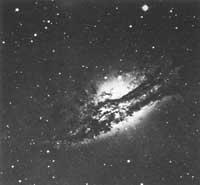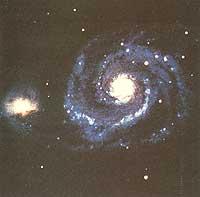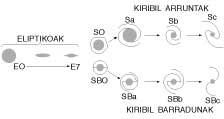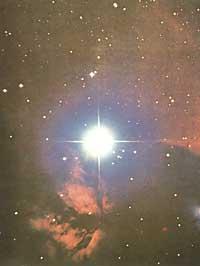Intergalaxy collisions (I)
1991/09/01 Arregi Bengoa, Jesus Iturria: Elhuyar aldizkaria
As is known, in addition to common galaxies (in addition to spirals, elliptics and irregular) there are other galaxies we call active. These processes are very violent and quasars are the most characteristic. But with all of them we also do not complete the spectrum of galaxies that offer the observations. There is still (2% of the total galaxies or completed) another group that remains outside the groups mentioned. They are generally very large, generally known as deformed, have numerous filaments and isasts and appear in pairs or small groups.
This last particularity was precisely the most important data to detect its origin: the galaxies described are a consequence of the collision between two or more common galaxies. The importance of shocks is also that many of the elliptical galaxies can be shaped by impact. However, we will try to clarify this second point next time.

It is logical to think that intergalactic shocks should not be represented as the shocks studied in the field of physics, but as a gravitational interaction. Interstellar gas and dust clouds are the main engine of these interactions. Therefore, the consequences will be very different depending on whether or not there is contact between galaxies, size, etc. As we shall see later, the stars move under the orders of the gravity field, but do not suffer collisions between them.
Well, the consequences can be those described or much more particular when analyzing the interaction between the French Way and the Magellanic Clouds, such as ringed galaxies or galaxies with filaments, antennas, matte accumulation points, etc. Examples of these and other structures B. A. They can be found in the atlas made by Soviet astronomers Vorontsov - Velyaninov.
In the constellation of Canes Venatici we have a very recognized pair of galaxies, formed by M51 (NGC5194) and ngc5195. The first has a spiral structure and the other probably was like that, but much less. It is believed that the latter, a period of hundreds of millions of years orbiting around the other, has quite deformed its spiral structure by touching one of the two arms of the M51. In turn, the distribution of the ngc555 stars has been reorganized, giving them a barren spiral galaxy still indefinite.
A very special structure has also been created as a result of the collision of galaxies NGC4038 and NGC4039, two filaments or antennas that develop in opposite directions from the center.
Another very spectacular example is the ring-shaped galaxies. They are classified into three groups: RE (formed by an empty elliptical ring, without appearing anywhere the nucleus occupied by galaxies), RN (galaxies in the form of an elliptical ring with a nucleus that is not in its center) and, finally, RK (those in which the condensation that can be nucleus is in the ring itself). Apparently, these galaxies come from an elliptical and spiral that have collided full. In this case, logically, interaction is much stronger than on previous occasions.
The image shows the steps of evolution that we will expose immediately. When at first the elliptical galaxy enters the nucleus of the other, and about a million a year, which can last the process, the stars of the other galaxy move out forming the ring. In these cases, in addition, the elliptical galaxy that has caused the redistribution is seen near the ring.

In spite of the fact that when the shock occurs a galaxy is totally immersed in the other, as in the last case described, there are hardly any collisions between stars. The average distance between the stars is 10 million times its diameter. Therefore, despite the immersion of galaxies and the doubling of density, collisions between stars are very difficult.
We are talking about the probability of collisions between stars being practically zero, but what is the probability of collisions between galaxies? The mean distance between galaxies is only sixty-half of its diameter and even smaller in clusters. The speed with respect to the Baricentro, meanwhile, is around 1,000 km/s, with barely two million light years. Consequently, the average time between the impacts a galaxy can bear is 15 billion years, that is, the age of the Universe. Therefore, the average impact a galaxy has suffered is one. As you can see, the probability is not negligible and therefore all the structures described have been created.
Finally, we will mention a peculiarity of the galaxies affected by the shock. Due to tidal effects, interstellar gas and dust clouds easily initiate compression processes. Therefore, they have many young and blue stars and little interstellar matter.
EPHEMERISSUN : 23 September enters Libra at 12 h 47 min., autumn equinox.
PLANETS
|

Gai honi buruzko eduki gehiago
Elhuyarrek garatutako teknologia





